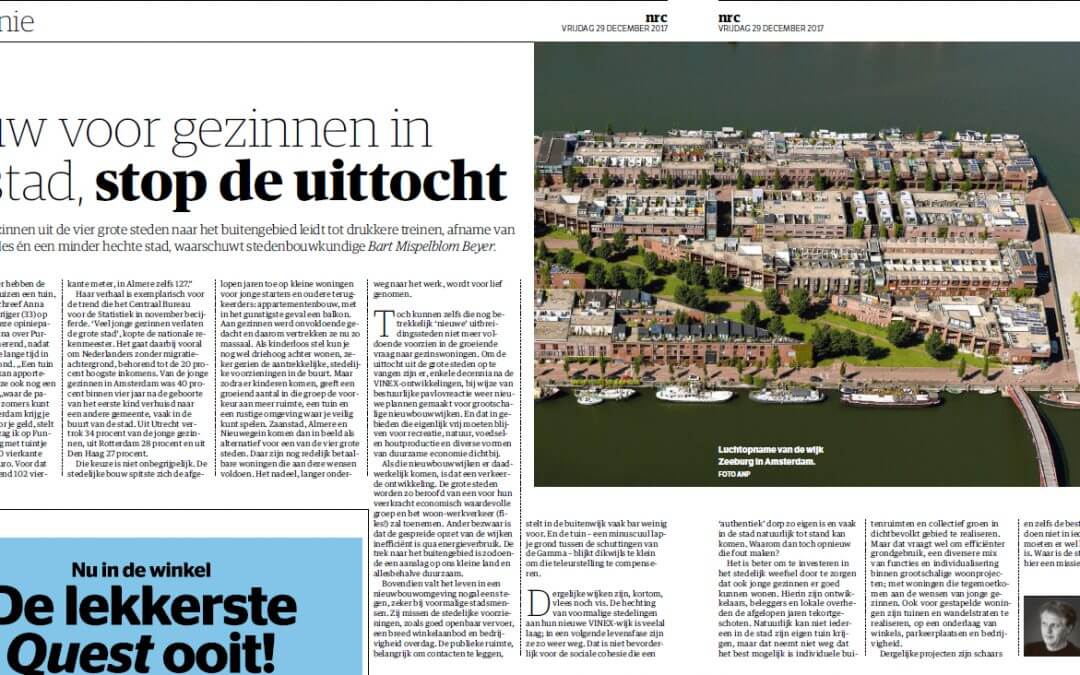The migration of families from the four major cities to the outskirts leads to busier trains, a decrease in nature, more traffic jams and a less dense city, warns urban planner Bart Mispelblom Beyer.
December 29, 2017
Here the houses have a garden, wrote Anna Krijger (33) on this opinion page about Purmerend, after she had lived in Amsterdam for a long time. “A garden in which your dog can retrieve the ball.” Then she also made a plea for Almere, “where the paths are wider” and “you can barbecue in the summer”. In Amsterdam you get very little for your money, she notes. “This week I saw a ground floor apartment with a garden in Amsterdam East at Funda: 50 square meters for 260,000 euros. For that money you get 102 square meters in Purmerend, even 127 in Almere. ”
Her story is exemplary of the trend that the Central Bureau of Statistics calculated in November. “Many young families are leaving the big city,” headlined the national auditor. This mainly concerns Dutch people without a migration background, who are among the 20 percent highest incomes. Of the young families in Amsterdam, 40 percent had moved to a different municipality, often near the city, within four years of the birth of the first child. 34 percent of the young families left Utrecht, 28 percent Rotterdam and 27 percent The Hague.
That choice is not incomprehensible. In recent years, urban construction has focused on small houses for young starters and older returnees: apartment construction, with a balcony at best. Families were insufficiently thought of, which is why they are leaving so en masse. As a childless couple you can still live three stories behind, especially considering the attractive, urban facilities in the area. But as soon as children arrive, a growing number in that group prefer more space, a garden and a quiet environment where you can play safely. Zaanstad, Almere and Nieuwegein then come into the picture as an alternative to one of the four major cities. There are still reasonably affordable homes that meet these requirements. The disadvantage, longer on the way to work, is taken for granted.
However, even those relatively “new” expansion cities can no longer adequately meet the growing demand for family homes. A few decades after the VINEX developments, new plans for large-scale new-build neighborhoods have been made by way of an administrative pavlov reaction to deal with the exodus from the large cities. And that in areas that should actually remain free for recreation, nature, food and wood production and various forms of sustainable economy close by.
If those new-build neighborhoods are actually built, it is a wrong development. The big cities will be robbed of an economically valuable group for their resilience and commuter traffic (traffic jams!) will increase.
Another drawback is that the spread of the neighborhoods is inefficient in terms of energy consumption. The migration to the countryside is therefore an attack on our small country and anything but sustainable. Moreover, life in a new construction environment is often disappointing, especially with former city people. They lack urban facilities, such as good public transport, a wide range of shops and daytime activity. Public space, important for making contacts, is often very little in the suburb. And the garden – a tiny patch of land between the fences of the construction market – often turns out to be too small to make up for that disappointment. In short, such neighborhoods are neither meat nor fish. The attachment of former city-dwellers to their new VINEX district is often low; they will be gone in a next phase of life. This is not conducive to the social cohesion that is so typical of an “authentic” village and can often be achieved in the city. Then why make that mistake again?
It is better to invest in the urban fabric by ensuring that young families can live well there. Developers, investors and local authorities have failed to do this in recent years. Of course, not everyone in the city can have their own garden, but that does not alter the fact that it is best to realize individual outdoor spaces and collective green areas in densely populated areas. But that does require more efficient land use, a more diverse mix of functions and individualisation within large-scale housing projects; with homes that meet the needs of young families. Gardens and pedestrian streets can also be realized for stacked houses, on an underlay of shops, parking spaces and business activities. Such projects are scarce and even the best examples do not suffice in every way. But they have to get there before it’s too late. Where is the urban government? When are they making this a mission?
Bart Mispelblom Beyer
www.nrc.nl/nieuws/2017/12/29/bouw-voor-gezinnen-in-de-stad-stop-de-uittocht-a1586498

